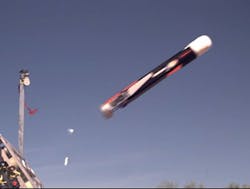Navy developing swarms of cooperating drones to launch overwhelming attacks
ARLINGTON, Va., 11 May 2015. U.S. Navy researchers have demonstrated swarming unmanned aircraft systems (UAS) designed to overwhelm an adversary autonomously as the UAS fly together like flocks of birds.
UAS experts at the U.S. Office of Naval Research (ONR) in Arlington, Va., announced they have conducted recent technology demonstrations of swarming drones as part of the Low-Cost UAS Swarming Technology (LOCUST) program.
The LOCUST program is developing enabling technologies to help sailors and Marines launch overwhelming swarms of reconnaissance and armed UAS from launchers on land or at sea.
The LOCUST program includes a tube-based launcher that can send UAS into the air in rapid succession. The drones then share information among themselves on a wireless network to coordinate their behavior in defensive or offensive missions, Navy officials say.
Navy researchers are designing UAS and launchers small enough to operate from surface ships, land vehicles, manned aircraft, other UAS, or unmanned marine vehicles. Navy researchers also are working on small reconnaissance UAS that can be launched covertly from submarine missile tubes.
Related: Army orders 19 MQ-1C Gray Eagle reconnaissance and attack drones for aviation support
The ONR LOCUST demonstrates were last month in several locations, and included Coyote UAS able to carry varying payloads for different missions. A separate nine-UAS demonstration showed autonomous UAS synchronization and formation flight, ONR officials say.
Even hundreds of small autonomous UAS cost less than one manned tactical aircraft; this capability will force adversaries to focus on UAS swarm response, officials say.
story continues below
“This level of autonomous swarming flight has never been done before,” says Lee Mastroianni, the LOCUST program manager at ONR. “UAVs that are expendable and reconfigurable will free manned aircraft and traditional weapon systems to do more, and essentially multiply combat power at decreased risk to the warfighter.”
ONR officials note that while the LOCUST autonomy is cutting edge compared to remote-controlled UAS, there will always be a human monitoring the mission, able to step in and take control as necessary.
ONR announced the LOCUST demonstrations this week at the Navy League Sea-Air-Space conference and trade show in National Harbor, Md. For more information contact the Office of Naval Research online at www.onr.navy.mil.

John Keller | Editor-in-Chief
John Keller is the Editor-in-Chief, Military & Aerospace Electronics Magazine--provides extensive coverage and analysis of enabling electronics and optoelectronic technologies in military, space and commercial aviation applications. John has been a member of the Military & Aerospace Electronics staff since 1989 and chief editor since 1995.

